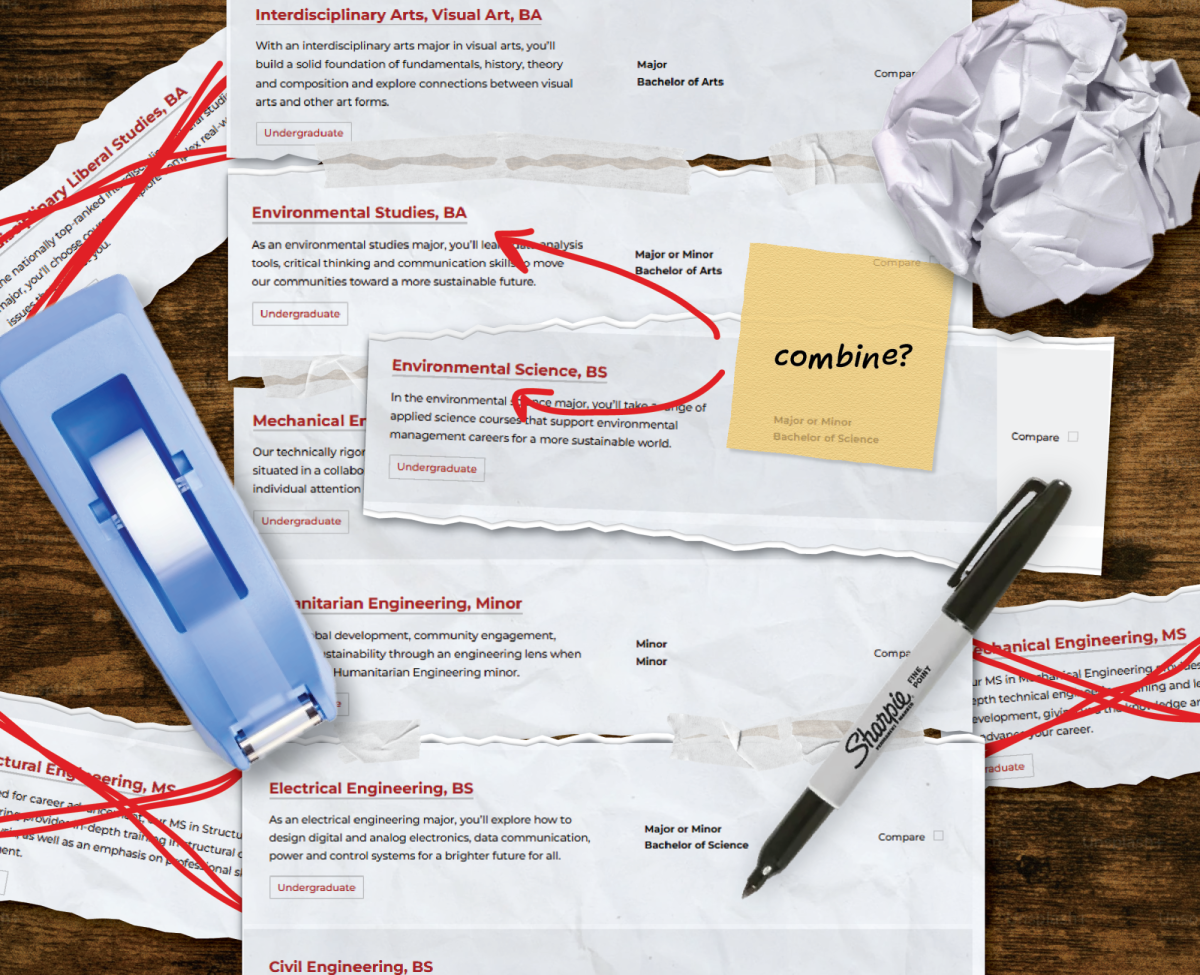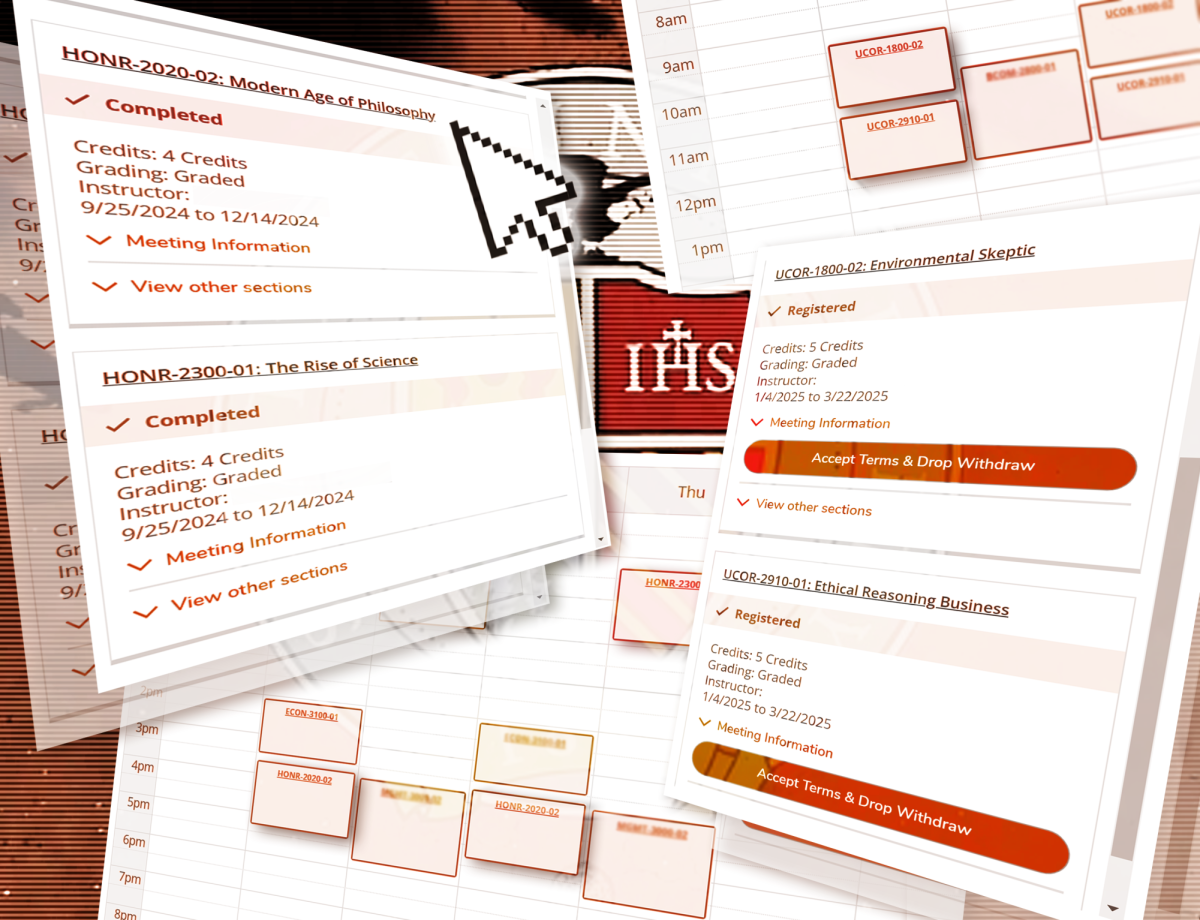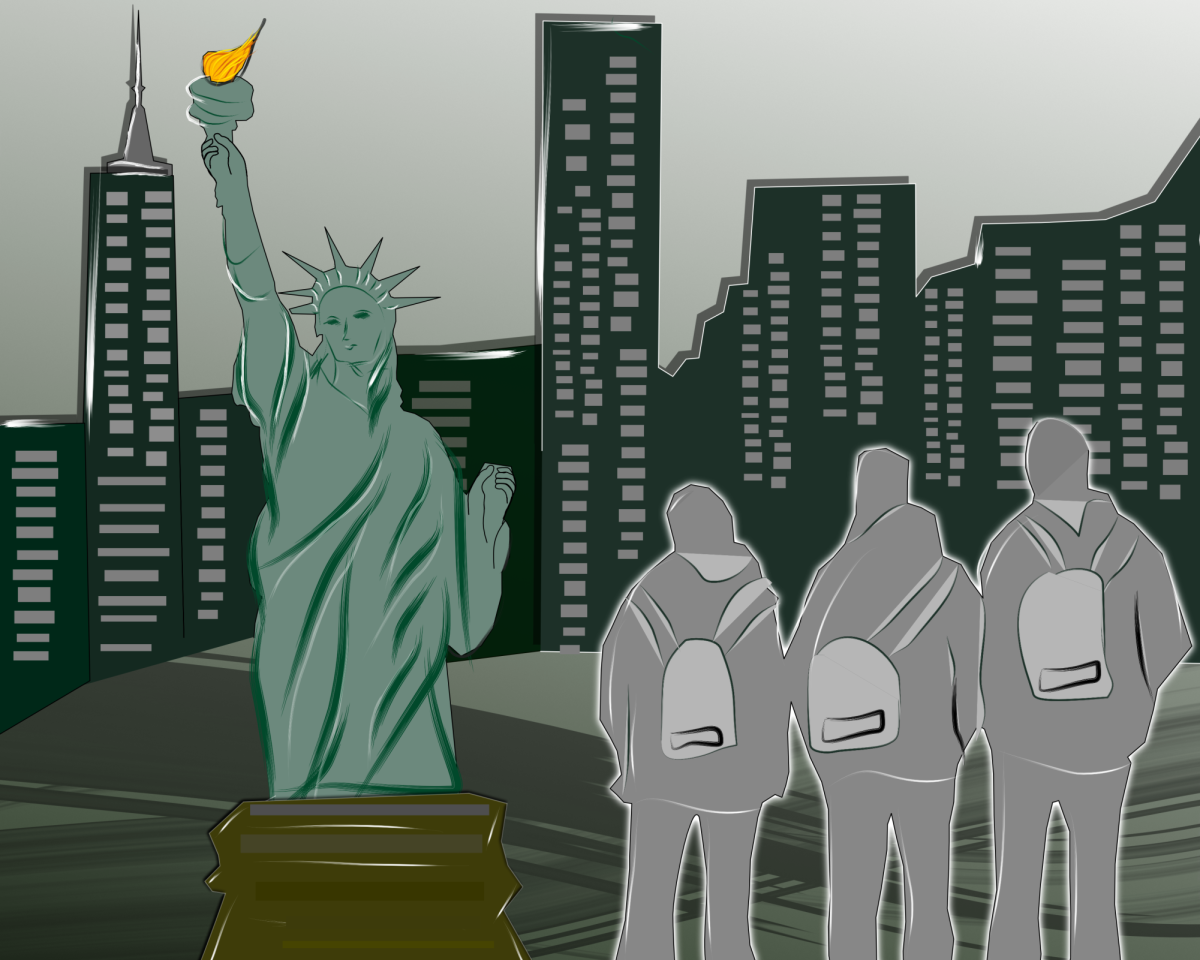Earth Month 2025 began, as it often does, with an email from Academic Affairs to all students reminding them of the late Pope Francis’ 2015 encyclical Laudato Si’. This letter implores humanity to, “care for our common home,” in a nuanced document almost one hundred pages long. Among other things, it calls for sustainable development, dialogue between religion and science and confronting the educational challenge of rethinking humanity’s relationship to the environment.
But another message went out in Earth Month 2025, this one to recently admitted students. It informed them that, come fall, the university would no longer be offering the environmental science major they had applied for. As Laudato Si’ celebrates its 10th anniversary, Seattle University marks the last year that students can enroll in environmental science, a major whose website states students will, “make an immediate impact on one of the most important—and complex—problems of our time.”
At a board meeting and retreat from March 13-14, the Seattle U Board of Trustees voted to terminate the BS in Environmental Science degree and six other academic programs. The other programs being terminated are BA Interdisciplinary Liberal Studies, MS Structural Engineering, MS Mechanical Engineering, MA/MEd Educational Administration, Principal PM Certificate, and Program Administration PM Certificate.
Four other programs are also being restructured. These programs are BA Public Affairs, MA Public Administration, MA Nonprofit Leadership and Certificate in Fundraising Leadership. No full-time faculty will be fired as a result of the changes to these programs and all enrolled students will be able to finish their majors.
These programs were selected for termination by the provost’s office and Chief Financial Officer’s office, which faculty were informed about at a March 10 meeting of Academic Assembly (AcA). This assembly is the main mechanism for shared governance at Seattle U, allowing faculty to work directly with the provost on major decisions. Shared governance is outlined in the Seattle U Faculty Handbook, and Section XII of the handbook explains the process by which academic programs are cut.
Section XII is titled “Termination of Appointment for Institutional Reasons.” The section also outlines the procedure for program elimination, a process that does not start at the provost level. Program termination is not discussed in any other section of the handbook.
“Program, degree program or department reduction or elimination may occur only after review by the Dean and the appropriate faculty governance body at the school or college level, which will make its recommendation to the Academic Assembly,” Section XII reads.
After this section, the handbook characterizes any reduction or elimination of faculty as a consequence of educational program reduction or elimination. Similarly to program elimination, faculty elimination is a decision that starts with the Dean and an appropriate faculty governance body.
“In the event of financial exigency or a decision to reduce or eliminate an educational program, the Dean and appropriate faculty governance bodies at the school or college level will make a recommendation for reduction(s) or elimination(s) of any faculty appointments to the Academic Assembly,” the handbook states.
This part of the handbook was not followed when the seven programs were selected for termination. A representative from the provost’s office shared their interpretation of this section, guided by the Office of University Counsel, in an email to The Spectator.
“The University did not follow Section XII of the Faculty Handbook, ‘Termination of Appointment for Institutional Reasons,’ because it does not apply to the Academic Program Analysis initiative. Section XII applies only to academic program closures that involve the termination of faculty appointments, and the Academic Program Analysis did not result in the termination of faculty appointments,” they wrote.
It’s easy to get lost in the complex language of our university’s handbook. Most students have never encountered the Faculty Handbook, and past spats over intricacies of the handbook, like its guidance on Jesuit identity in teaching, have receded into the collective rearview mirror of the university. So, why should this be any different?
For one, it has the potential to set a precedent for future cuts without consulting faculty. Seattle U is projecting a financial deficit of over $7.5 million for the current year and Chris Malins, the university’s CFO, previously told The Spectator that changes to faculty and programs were one avenue the university was looking at to reduce the deficit. These cuts, under the Academic Program Analysis initiative, are a sign that the university is willing to slash programs without consulting faculty to get the deficit under control.
This method of terminating programs may soon be cemented in the Faculty Handbook. The Provost’s Office shared with The Spectator that they are working on amending the handbook with AcA, to “clarify the framework for faculty participation in Seattle University’s system of shared governance for situations like this one,” the provost’s office wrote.
Future amendments could create a direct path for cuts called for by the university’s president and the Board of Trustees. This has already happened; the provost’s office shared that Seattle U President Eduardo Peñalver requested the cuts.
“As directed by Goals one and five of Strategic Directions, which was approved by the Board of Trustees, President Peñalver asked the provost’s office and CFO’s Office to jointly engage in the Academic Program Analysis initiative,” the provost’s office said.
This initiative used a number of factors to flag programs as underperforming. These factors, shared with The Spectator by the Provost’s Office, were credit hours, student to faculty full-time equivalent ratio, graduation rates, enrollment, average course size, admissions, financials and academic factors.
This numbers-based approach led to the elimination of these seven underperforming programs by the Provost’s Office. Faculty and students felt that the human side of the equation was not fully factored in.
Faculty feel strongly about the unique contributions of their programs. Wes Lauer, the chair of the civil and environmental engineering department and former director of the environmental science program, shared that the program changes have been challenging for him, his colleagues and their students.
“The Environmental Science program has served some of the strongest, most motivated, most collaborative students I’ve worked with at SU. It’s truly been a privilege to guide them as they learn to apply science to help us understand our place in the natural world,” Lauer said.
In the Interdisciplinary Liberal Studies (IDLS) major, students had unique opportunities to work across disciplines. The Elementary Education specialization was the only education program where students graduate with a Bachelor’s degree and their teaching certificate at the same time, allowing them to immediately start teaching after graduation.
IDLS majors like Caitlin Tips, a fourth-year student, found out April 1 that their program was being terminated.
“I genuinely was convinced it was an April Fool’s joke for a moment,” Tips said. “[They] said you will be graduating with this degree, but we are terminating it, or technically merging it into the Matteo Ricci Institute because of low enrollment,” Tips said.
Student Government of Seattle U (SGSU) President Sophia Cofinas, a fourth-year public affairs and international studies major, shared that students were not involved in this decision at any stage, through the student government or other means.
“My perspective from SGSU’s involvement is that we were not involved, we were not aware of the program cuts until the decision had already been made, and we have, via my voice in the Board of Trustees meeting and other spaces, suggested and advised that the student voice be more present in these decisions and look forward to the administration hopefully taking that into account,” Cofinas said.
Beyond the lack of student or faculty voices in decision making, faculty like Phillip Thompson, a professor in the civil and environmental engineering department, are concerned about a perceived lack of transparency around the data used to terminate programs.
“No one in my department has seen any metrics that justify the closure of the Environmental Science program. Our [CSE AcA] reps have also confirmed that they have not received any data either,” Thompson said.
These cuts are reminiscent of an effort that emerged in 2020. Amid the pandemic, a new committee was introduced to AcA, called the Academic Portfolio Program Review (APPR). APPR brought together representatives from each college, the budget office and the provost’s office, who worked to “recommend programs to the BOT for potential sunsetting.” The program hoped to reduce university expenditures by 10% to deal with a financial deficit under previous University President Fr. Stephen V. Sundborg, S.J.
The committee provided a number of updates at AcA meetings, reflected through meeting minutes from the 2020 academic year. Discussion at a July 20, 2020 meeting indicated how faculty at the time felt about paring down academic offerings through a process rooted in robust faculty engagement.
“Some faculty are uncomfortable with the structure of the APPR. The APPR has been created purely for financial reasons and remains a little unclear about its goals and guiding principles.”
APPR was postponed in early 2021, due to a lack of transparency and outcry from multiple faculty groups.
Some elements of APPR returned in Reigniting Our Strategic Directions, Seattle U’s strategic plan put forth by President Peñalver in 2022. Goal 5, which the provost’s office cited earlier along with Goal 1, describes exactly what the administration has done with their Academic Program Analysis: making a difficult decision to change and sunset programs to cut the school’s budget deficit. The Strategic Directions plan also states, “We will do so in a transparent and equitable way using clear criteria for decision making.”
This spring, environmental science seniors will present their year-long capstone project, a hallmark of the program that distinguishes it from programs like environmental studies and civil and environmental engineering. The six students in this year’s graduating class, the same number of seniors as last year, have spent the year working on research with professional sponsors.
One of the capstone groups is working with computer science students on an interdisciplinary project supporting a forest management consulting firm to collect forest data using drones. It calls to mind Goal 1 of Reigniting Our Strategic Directions, the same one used to direct the program’s termination, which puts an emphasis on “encouraging interdisciplinary approaches and employing Ignatian pedagogy.”
Goal 1 also sets curricular priorities for the university. At the top of the list: sustainability and climate change.














